Is Montreal the number one city for bicycling in North America
Am vacationing in Montreal. We`re staying in a house in `The Village` area, which is about one block away from the Beaudry Metro Station, and five blocks from the Berri-UQAM Metro Station, which is the equivalent of `DC`s `Metro Center`where three of the four lines cross--so getting around by transit is easy, especially combined with bus, of course things are close and you can get to many places on foot.
I know that Portland, Oregon and Davis, California duke it out over which is the best city for bicycling in the United States. And New York City, with the variety of initiatives that have come forth there over the past two years under Transportation Commissioner Janette Sadik-Khan, is a rising contender.
Now I haven`t been to Portland for a few years, so I imagine that it has improved for biking in the intervening years, and it was already a great example of bike commuting and accommodating bicyclists on bridges. Certainly, the Intiative for Bicycle and Pedestrian Innovation at Portland State University is pumping out great information, such as the manual
FUNDAMENTALS OF BICYCLE BOULEVARD PLANNING & DESIGN by Lindsay Walker et al.
But, seeing how Montreal has an extensive network of piste cyclables or bike paths, which include cycle tracks, or dedicated lanes for bicyclists, located within the road right-of-way throughout the city--and they are used--and function like the cycle superhighways that Boris Johnson claims to be bringing to London and what Tom Vanderbilt writes about in Salon, Bicycle Highways: Should cities build specialized roadways for cyclists? -- although note that this is something that Professor John Pucher of Rutgers University has been saying-writing-researching-presenting-speaking about for many years before Tom Vanderbilt -- clearly the answer is yes.
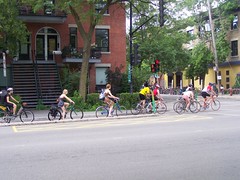
Piste Cyclable on Rue Rachel, Montreal (across from Park Fairmount).
Although some of the writing is a bit misleading because cycle tracks, while dedicated, don`t have to be separated from the overall roadway, they are placed within it, but in a protected fashion.
The interesting thing about the cycletracks in Montreal is that they are not placed on each side of the roadway, in the same direction as the traffic. Instead, they are two way lanes placed on one side of the street.
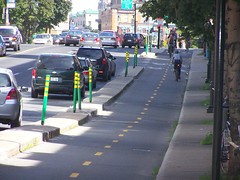

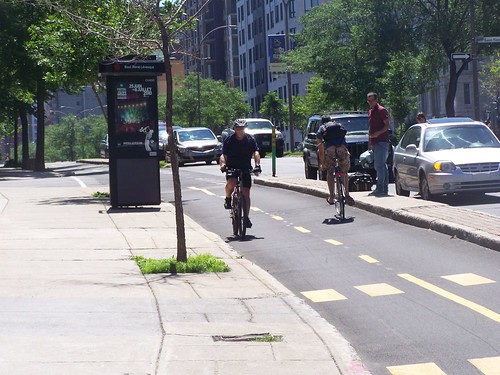
But cycle tracks-cycle superhighways aren`t the only reason that Montreal should be considered the number one place for cycling in North America. Besides the fact that people actually bicycle in the lanes (e.g., I`ve barely seen people use the contraflow cycle track on 15th Street, while the cycle tracks in Montreal are teeming with cyclists--some duded up in cycling gear and clothing, but most not--maybe the cyclists aren`t as pretty as those featured in Copenhagen Chic or Riding Pretty blogs, but they are transportational cyclists nonetheless.
Signs for the Route Verte abut a bicycle sharing station in Montreal.
Now the Transportation agency has a publication, Making cycling a mode of transportation in its own right, which discusses the provincial bicycle policy and programs to aid àlternative modes of trnasportation to the car.` According to the publicaiton, Quebec is the place in North America where bicycling is most widespread, as proportionally there are 2.5 times more cyclists in Quebec than in Canada as a whole, and 2 times more than in the U.S.
The link to the publication is the longer piece. I came across a four page brochure in an information rack in a local museum (in both French and English).
But then there is Bixi, the bicycle sharing program in Montreal.
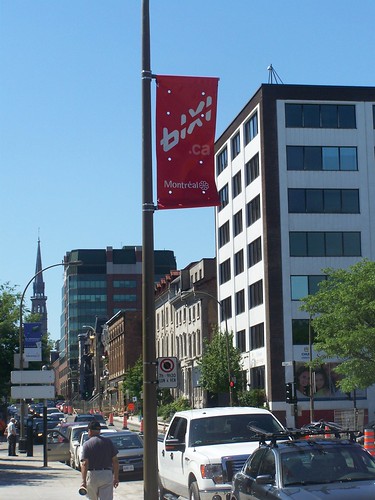
A street banner promoting the Bixi bicycle sharing program in Montreal
Now us Washingtonians get bent out of shape when Bixi claims that they are the first public bikesharing program in North America, when the SmartBike program in DC was first. BUT, being here, I guess I see their point. The DC program is a pilot, with a handful of stations (something like 10) and maybe 150 bikes--which are barely use as each bike experiences fewer than 2 trips per day, while the Montreal system is widespread with 400 stations and 5,000 bicycles, and they are set up to be used not just by subscribers--the DC system is restricted to subscribers, but by anyone with a credit card, someone like me, who is visiting...
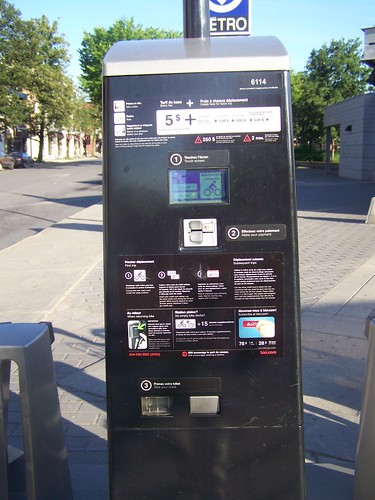

Bixi station map.
The stations are placed no more than 300 meters (1,000 feet) apart. Because Montreal is actually made up of separate arondissements, kind of like towns, parts of the city are not covered by Bixi because of lack of density or because the arondissement, such as Westmount, see `Westmount in 'no rush' for Bixi` from the Montreal Gazette, does not participate.
If you know how to bike, how to use a credit card, how to `consume` a city, and how to read a map (although it took me a few minutes to figure out how to unlock a bike from the station) you can use Bixi whether or not you are a `member`.
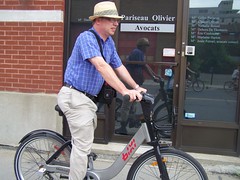
(I definitely wouldn`t be able to get my photo in one of the pretty riding blogs.)
It really allows you to explore far more of a city--block by block--than you can by regular transit. (Now there are reasons why such a system works better in Montreal than in a place like DC but I`ll write about that when I get back.)
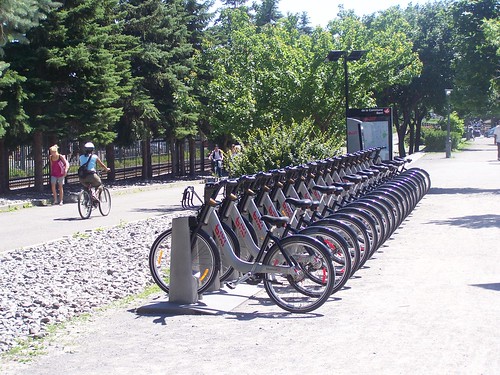
Bixi station approaching the Old Port of Montreal

Above and below, Bixi cyclists in the Old Port of Montreal.
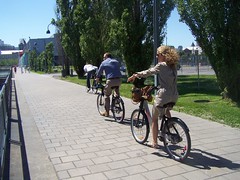

Woman on a Bixi in Victoria Square, Montreal.
As an indicator of a high rate of bicycling--biking is part of how people get around day-to-day, what some people call `culture`but what I think of as bicycling as a part of every day mobility behavior or ``way of life``--that there are public bike racks in neighborhoods, because of a need to secure bikes and people living in smaller places or on upper floors, when bringing a bike in can be a problem.
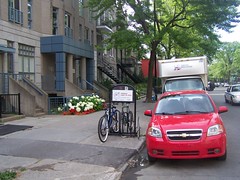
Finally, the thing that puts Montreal to the number one position may be the fact that
Vélo Québec, the city and provincial bicycle advocacy organization, has the makings of the `bike center` that WashCycle got our hopes up on in an April fools blog entry. The VeloQuebec office on Rue Rachel, across from Fairmount Park is also a cafe, cycle bookstore, and cycle travel office.
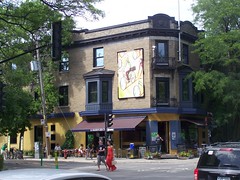

Vélo Québec also publishes a full-blown magazine, VeloMag, in French of course. The latest issue comes bagged with maps of various cities, such as Quebec City, which paid to include their bike maps as advertisements in the issue.
And Vélo Québec also publishes a fabulous (but expensive) manual for bike and pedestrian planning, (in French and English editions) which covers just about everything, even things I hadn`t considered when producing the forthcoming Western Baltimore County Pedestrian and Bicycle Access Plan...
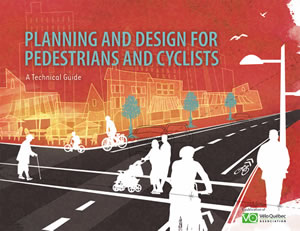
Maybe all of that doesn`t make Montreal the number one city for bicycling in North America--I did notice that they only provide certain services (Bixi and bike lanes) from April to November, which might mean that they don`t do snow clearance of bike lanes and paths in the winter--but it has to come pretty close.
Speaking of John Pucher, here is one of his articles that I have to read...
"Why Canadians Cycle More than Americans: A Comparative Analysis of Bicycling Trends and Policies," Transport Policy, May 2006, Vol. 13, pp. 265-279 (with Ralph Buehler). Click here for PDF.
Labels: bicycling, sustainable land use and resource planning, transportation planning

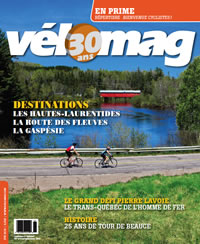



1 Comments:
https://www.inquirer.com/opinion/montreal-city-council-state-budget-new-jersey-20251017.html
No offense to Hoboken, but Philly should aim to mimic a peer city that’s a little farther north
Post a Comment
<< Home